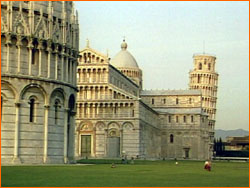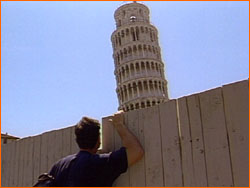 |
 |
 |
Part 2 | Back to Part 1 NOVA: In your opinion, will the tower remain standing indefinitely, or is it still liable to sudden collapse even, say, after the full intervention? Burland: As far as the foundations are concerned, I'm satisfied that the tower would not be liable to sudden collapse anymore. I think we will have done enough to stabilize the tower permanently. By reducing the inclination of the tower, we've reduced the forces in the masonry, and we're also doing some strengthening. I don't think anyone could do more than we have done, but the masonry remains uncertain. We don't know exactly how strong it is. I think that if the tower were going to go, that's where the weakness would be, though it would probably require a pretty major earthquake or quite significant deterioration in the masonry itself for a major collapse to take place. NOVA: So it's never been a case of the tower actually tipping over? It's more of a downward collapse? Burland: Actually, when we first came on the job, there was a danger of it tipping over, because the tower was accelerating. I think we've pulled back from that problem. We've already brought the tower back to where it was in 1970, and all the indications are that soil extraction will continue to be effective. NOVA: Does it surprise you that the tower has stood so long on such a weak foundation? Burland: Yes, it does, because the tower has had at least three very narrow escapes. The original builders stopped building it about eight years after they started and left it for 100 years, and we know that if they hadn't stopped, it would certainly have fallen over. They didn't know that; it was a complete fluke that they stopped, really. And they stopped again very near the top—again, for some unknown reason. If they hadn't, there's no question that it would have fallen over. NOVA: Because the soft soil hadn't had time to compact? Burland: That's right. Then in 1838, an architect dug a trench around the base of the tower so that the people could see the foundations and the bottom of the columns, which had become buried as the tower subsided. Over a few days that year, the tower lurched about half a degree, or half a meter or so. It must have been terrifying. How it didn't fall over, nobody knows.
Burland: Not recently, no. We've still got the Chinese engineer who claims that he's straightened 80 pagodas, though he never told us what his method is, and we keep getting various other suggestions. The problem with almost all the suggestions is that they're probably viable—if only you could implement them. But all of them would have the tower over while you were trying to implement them, and that's always been the big problem: finding a method that you can implement without destabilizing the tower.
Burland: I've been involved in quite a number of historic buildings. I suppose the two with which I've been most involved are, first of all, the Metropolitan Cathedral in Mexico City, which has undergone enormous differential settlements due to pumping water out from very low down in what is a very soft, volcanic lake bed. The cathedral has settled differentially by about two-and-a-half meters. We used this process of under-excavation there to straighten the Cathedral out, to reduce the kinks and deflections in it, and it's been very successful. My life seems to be plagued by towers, because the other big project I've been involved in over the last few years has been insuring the stability of the Big Ben clock tower during the construction of an underground railway alongside it. There we did the reverse of what we're doing at Pisa; we pumped grout into the ground. Every time Big Ben tilted a little bit, we pumped grout in and stopped it leaning. We could do that because the ground in London is much stronger than it is in Pisa. We wouldn't dare do that at Pisa; that would probably have the tower over. NOVA: Now if you achieve your half meter in the full intervention, will the tower then be open to the public? Burland: That's the intention, to reopen the tower. I'm sure that millions of people will come, and hopefully what we've done will have actually added to the enigma of the whole structure. At the same time, it's very important that we don't relax and become complacent, because there's a long way to go, and we've got to be very, very vigilant. Animation: Digigraf/Paneikon Pisa Panorama | Where it Stands Today | The Galileo Games Rescuing World Monuments | History of Interventions | Resources Teacher's Guide | Transcript | Site Map | Fall of the Leaning Tower Home Editor's Picks | Previous Sites | Join Us/E-mail | TV/Web Schedule About NOVA | Teachers | Site Map | Shop | Jobs | Search | To print PBS Online | NOVA Online | WGBH © | Updated November 2000 |
 See an animation of the Leaning Tower
collapsing.
See an animation of the Leaning Tower
collapsing. Burland says that most suggestions for how to straighten
the tower would "have it over" while implementing the ideas.
Burland says that most suggestions for how to straighten
the tower would "have it over" while implementing the ideas.
 The ultimate goal is to reopen
the Leaning Tower to tourists, who have been unable to ascend the tower since
its closing in 1990.
The ultimate goal is to reopen
the Leaning Tower to tourists, who have been unable to ascend the tower since
its closing in 1990.